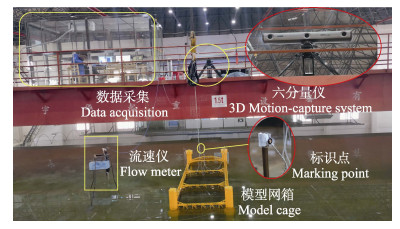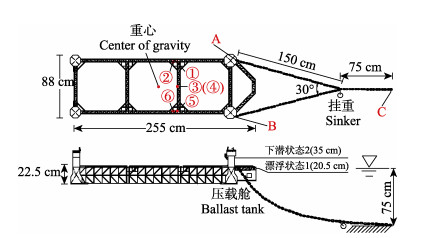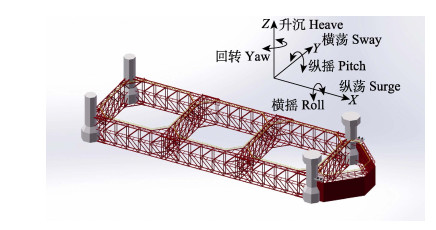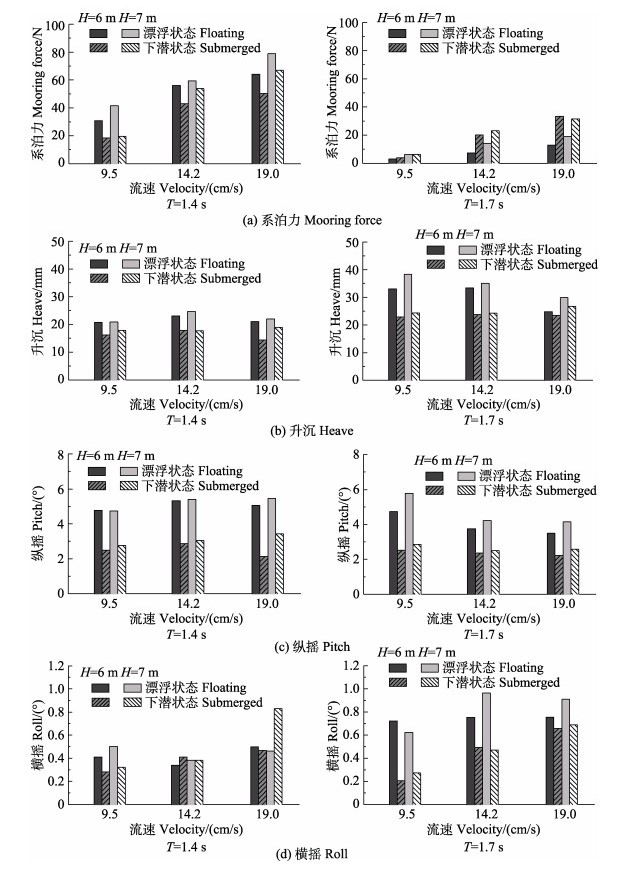2. 中国水产科学研究院南海水产研究所广东省网箱工程技术研究中心 农业农村部外海渔业开发重点实验室 广东 广州 510300
2. South China Sea Fisheries Research Institute, Chinese Academy of Fishery Sciences; Guangdong Cage Engineering Research Center; Key Laboratory of Open-Sea Fishery Development, Ministry of Agriculture and Rural Affairs, Guangzhou, Guangdong 510300, China
网箱养殖作为现代海洋渔业一种重要的生产模式,为我国海洋水产品的稳定供给提供了有力的支撑。2019年我国海水鱼类养殖产量为160.6×104 t,其中网箱养殖产量占比47.1% (农业农村部渔业渔政管理局等, 2019)。目前主流的离岸养殖网箱为大型高密度聚乙烯(high density polyethylene,HDPE)重力式深水网箱(黄小华等, 2019)。深水网箱放置在开放性水域,是水深在15 m以上的大型网箱(石建高等, 2021),一般由浮架系统、网衣系统、配重系统和锚泊系统组成。
作为网箱养殖走向外海的第1步,国内外学者围绕其在海洋环境荷载下的水动力学特性开展了较多的研究,主要的研究方法有物理模型试验(崔勇等, 2015; Bi et al, 2018; Liu et al, 2019; Qu et al, 2019)、数值模拟(Cifuentes et al, 2017; 崔勇等, 2019; Hou et al, 2022; Tang et al, 2020; Liu et al, 2021)和海上实测(郭根喜等, 2010; DeCew et al, 2013; Gansel et al, 2018)等。然而,从以往的研究发现,重力式深水网箱一般采用沉子即配重系统来维持网箱的养殖空间,易变形的特点使其可以形成不同网箱结构,在波浪流等环境荷载作用时,能一定程度上减小对网箱的作用(Xu et al, 2020),但同时也面临着在环境荷载较大时网箱养殖空间大幅度减小,影响养殖鱼类正常生长,甚至造成挤压等问题(黄小华等, 2011)。其次,大型HDPE深水网箱日常运行管理高度依赖养殖管理平台或专业化养殖工船(郭根喜等, 2013),而深远海海域环境更为复杂恶劣,时常遭遇强风急流,该种养殖模式下的物料补给、饲料投喂等日常管理工作将严重制约深水网箱走向深远海。
为突破深水网箱的发展瓶颈,充分利用广袤的深海海域,具备养殖一体化管理的大型桁架式深海网箱设计理念在海内外水产业内萌发(何皛磊等, 2018)。2016年,挪威SalMar公司研发设计了一种采用钢结构建造的半潜式深海养殖网箱,该网箱由我国中船重工武船集团建造,养殖水体达25万m3,一次可养殖三文鱼(Oncorhynchus) 150万尾,整个网箱由8根缆索连接海底固定,可以抵抗12级台风。2017年,由挪威Nordlaks Oppdrett AS公司研发设计、中集来福士负责建造的“HAVFARM 1”号深水养殖网箱养殖水体高达40万m3,可养殖规模达1万t三文鱼。此后,我国深远海网箱也进入快速发展期,呈现出跃进式发展(石建高等, 2021),相继出现“深蓝1号”全潜式深海网箱、“德海1号”半潜桁架结构大型智能化养殖网箱、“长鲸一号”深远海智能化坐底式网箱、“海峡1号”单柱式半潜深海网箱等。大型深远海网箱的相关动力学理论研究也逐步跟进,Li等(2018、2019)通过数值模拟的方法为一种船型网箱设计了采用6条系泊线的单点系泊系统,并考虑极限状态对该系泊系统进行优化设计,以保证网箱安全稳定运行。Yu等(2019)采用有限元软件进行船舶与大型深远海网箱“Ocean farm 1”的碰撞分析。Zhao等(2019)通过物理模型试验研究了波浪要素、网衣及不同吃水深度对“Ocean farm 1”深海网箱的系泊力和运动特性影响,结果表明,在添加网衣后网箱的升沉和纵摇都有所增大。Huang等(2020)针对“德海1号”网箱,比较分析了3种不同的单点系泊方式的系泊受力,并基于其中安全稳定性能最优的系泊方式研究网箱在波浪流作用下的运动响应。本文研究对象为一种采用单点系泊系统(single-point mooring, SPM)的大型潜浮式船型桁架结构深海网箱,重点围绕网箱动力响应开展水池试验研究。以网箱系泊力、升沉、纵摇和横摇等水动力学特性为依据,研究分析大浪条件下网箱下潜后的避浪性能及海流流速对网箱避浪性能的影响,旨在了解潜浮式深海网箱不同状态时受外界环境荷载作用的动力响应特性,评估网箱下潜后的避浪性能,为网箱运行和日常管理提供理论数据支撑。
1 材料与方法 1.1 试验设备试验在中国水产科学研究院江苏如东试验基地进行,水池长50 m、宽26 m、深1.2 m,造波机总宽24 m,为减少二次反射波影响,水池前端及两侧配备直立式消能网,尾端为斜坡式消能网。其他设备包括浪高仪、拉力计、六分量仪、数据采集系统、计算机等。浪高仪采用大连理工大学研制的LYL-Ⅲ型浪高仪,量程范围为0~50 cm,相对误差 < 1%。拉力计为具有良好温度特性和水密性能的应变式水下拉力计,量程为200 N,误差 < 1%,布置在网箱艏部两侧,一端连接导缆孔,另一端连接锚链。六分量仪为加拿大NDI公司设计研发,采用实时高速六维动态追踪系统(Optotrak Certus),可实现非接触式光学测量。主要工作原理是利用3个高分辨率、主频达2000 Hz的高速红外线阵相机来捕捉标识点发射的红外光,得到多个标识点的空间坐标及转动信息并实时输出(图 1)。

|
图 1 模型试验布置图 Fig.1 Layout of model test |
本文研究对象基于深海网箱潜浮式概念设计,采用全锚链单点系泊(SPM)系统,主体为船型桁架与浮体混合结构,原型长102.2 m、宽35.1 m、型深9 m,艏部浮体高17.5 m,艉部浮体高17 m。锚链采用直径为62 mm的AM 3级锚链钢,单位长度质量为84.2 kg/m,挂重为5 t。通过前、后端浮体压载水实现网箱主体框架的整体上浮和下潜,满足养殖过程的操作需求。设计吃水深度见表 1。其中,漂浮状态是网箱运行的常态(图 2),此时养殖平台日常工作的廊道高出水面2 cm (原型0.8 m);当大浪强流等恶劣海况来临时,网箱即进入下潜状态(图 2),网箱主体结构基本下潜至水面以下,躲避大浪冲击与保护养殖鱼类。需要说明的是,由于此时水面线高出廊道12.5 cm (原型5 m),而养殖空间是以桁架为依托用网衣编围而成,在漂浮状态时并没有进行顶部封盖,因此,网箱下潜前需要用网衣将养殖区域进行封闭,防止养殖鱼类的逃逸。
|
|
表 1 网箱结构主要参数 Tab.1 Main parameters of cage |

|
图 2 网箱不同工作状态 Fig.2 Cages of different draft states |
依据《波浪模型试验规程》(JTJ/T 234-2001)相关规定,同时考虑设备的综合能力,模型比尺设定为1∶40。根据重力相似准则,时间比尺为1∶
网箱系泊系统为单点系泊(SPM),实际运行中会产生随波逐流的特性(Goudey et al, 2001),相应的纵荡、横荡及回转与网箱的稳定性关联不高,为此本文不做探讨。仅考虑网箱的系泊力以及升沉、纵摇和横摇等3个自由度上的运动分量进行研究分析。
一般来说,对于离岸网箱的研究设计需要在风、浪、流和极端环境下进行响应分析。本研究重点围绕网箱在波浪和海流作用下的动力响应特性开展试验,针对网箱可以根据养殖需求而上下潜浮的设计方案,探讨在大浪强流的冲击下,潜浮式深海养殖网箱的避浪性能。试验内容主要包括网箱运行常态即本研究中的漂浮状态时网箱动力响应特性研究,以及探讨大浪条件下通过增大吃水深度进入下潜状态的网箱避浪性能,并在此基础上进一步分析海流对网箱避浪性能的影响。试验中所使用到的波流参数见表 2。
|
|
表 2 试验波流参数 Tab.2 Wave and flow parameters in physical model test |
根据《波浪模型试验规程》(JTJ/T 234-2001)规定,本研究将波浪平均波高和波周期偏差控制在±3%。波浪均为规则波,采用10~20个波的平均波高,每组工况进行多次,分析试验结果,剔除明显错误或重复性不好的试验组次,保留3组重复性较好的试验组次,取平均值。
由于本研究的船型桁架结构网箱采用的系泊系统配有挂重(图 3),如果将水下拉力传感器布置在锚定点(图 3C点),从试验过程观察,小波浪条件下挂重未脱离水池底面,使得水下拉力传感器测得受力几乎为零。为了更准确地测量获得小波浪和大波浪锚链的受力情况,故将拉力传感器布置在锚链上端更能反映锚链实时受力情况(见图 3A点和B点)。网箱系泊受力数据采用在网箱中线上的合力,即网箱系泊受力F=(FA+FB)×cos15°。为校核该计算方式的可靠性和准确性,进行验证试验,在水底锚定点也布置了1个测力计,将该点受力与A点和B点合力进行比较分析。图 4为采用2种方式的网箱受力历时曲线,可以看出,二者受力数据吻合较好,表明求合力的计算方式具有可行性。

|
图 3 网箱系泊方式示意图 Fig.3 Schematic diagram of cage mooring mode ①~⑥为六分量标识点;A、B、C 为测力计布置点。 ①~⑥ are the mark points of 3D motion-capture system; A, B, C points for tension meter. |

|
图 4 网箱受力历时曲线 Fig.4 Time-series of anchor chain tension of cage FA、FB、FC 分别为图 3 中 A、B、C 点的拉力计受力数据,F=(FA+FB)×cos15°。网箱为漂浮状态。 The real-time data of tension meter at points A, B and C in Fig.3, and F=(FA+FB)×cos15°. The cage is floating. |
本研究中,网箱运动响应采用非接触式光学测量,在网箱上布置6个标识点(图 3①~⑥点),通过6个标识点的方位建立一个空间直角坐标系将原点平移至网箱重心,进而获取网箱在平动和角动上的位移即网箱的6个运动分量。为便于固定,将标识点布置在网箱中部,采集主机则依据标识点位置,放置在正对网箱的工作桥上(图 1),保证网箱运动过程中也能观测到标识点。
2 结果与分析 2.1 网箱漂浮状态动力响应特性一般情况下,网箱运行多处于漂浮状态,本文重点围绕网箱漂浮状态时受波浪作用的系泊力、升沉运动、纵摇运动和横摇运动等水动力学特性展开研究,旨在了解网箱在运行常态时的动力响应特性相关参数,为网箱的设计建造、运行管理提供理论依据和数据参考。
表 3是网箱在漂浮状态时受波浪作用的动力响应特性变化。从表 3可以看出,网箱的系泊力与波高变化呈正相关,随波高的增大而增大。而与周期的变化关系由于试验只设置了2组周期,因此,不能准确得出,但可以看到周期为1.7 s波况条件下的网箱系泊力与1.4 s时相比,整体有所减小,波高为12.5 cm、周期为1.4 s时,系泊力最大(8.41 N),波高为7.5 cm、周期为1.7 s时,系泊力最小(0.62 N)。与系泊力不同的是网箱的升沉、纵摇和横摇值在周期为1.7 s时均明显增大。在本研究波况中,波高为12.5 cm、周期为1.7 s时均为最大,升沉值为44.28 mm,纵摇值为6.75°,横摇值仅为0.5°。结果表明,一般海况下网箱系泊受力及运动响应均较小,具备较高的安全性和稳定性。
|
|
表 3 网箱漂浮状态动力响应特性 Tab.3 Dynamic behaviors of cage in floating state |
在无屏障外海,深海网箱时常会遭遇浪高较大的恶劣海况。根据陶爱峰等(2018)对中国灾害性海浪的研究,目前,我国对灾害性海浪没有明确统一的标准。邢闯等(2013)研究认为,有效波高≥4 m的波浪为灾害性海浪;张薇等(2012)研究认为,1/10大波≥3 m的海浪为灾害性海浪;王华等(2007)研究认为,波高≥4 m的海浪为灾害性海浪。这是由灾害性海浪作用的承灾个体差异性导致的。本研究依据网箱适用海域以及试验场地的条件,选择波高为15.0 cm和17.5 cm (原型波高6 m和7 m)作为网箱下潜的波况条件,重点讨论2种不同状态网箱在大浪冲击下的运动响应特性,分析评估网箱在恶劣海况时的避浪性能。
|
|
表 4 大浪条件网箱下潜后的动力响应减幅 Tab.4 Dynamic behaviors variation of cage after diving under the high wave conditions |
图 6是大浪条件下2种状态的网箱动力响应特性变化。从图 6可以看出,当网箱下潜后,系泊力、升沉运动、纵摇运动和横摇运动均明显减小。本研究中,下潜后网箱系泊力减小到一个非常小的数值,相较于漂浮状态减幅达到70%以上;此外,升沉、纵摇和横摇等运动分量的减幅为20%~60%。结果表明,在网箱遭遇大浪冲击时,可以通过增大吃水深度将网箱整体下潜以躲避大浪冲击,同时,还能减小大浪对网箱内养殖鱼类的伤害。试验结果与黄小华等(2019)对“德海1号”深海网箱开展的研究结果有所不同,在其研究中空载时系泊力最小,随着吃水深度增加至满载时最大,而运动分量除升沉值有所减小,网箱的纵摇与横摇均有不同程度的增大。造成不同的原因可能与“德海1号”所采用的单点“一”型系泊以及其艏部三角形结构有关,同时,还可能与网箱吃水深度有关,其最大吃水深度为21.7 cm (原型6.5 m),网箱主体并未完全下潜。

|
图 5 网箱平动与角动位移 Fig.5 Illustration of translatory and angular displacement |

|
图 6 大浪条件下潜浮式网箱动力响应变化 Fig.6 Dynamic behaviors variation of cage under the high wave condition |
实际海况中,波浪的出现往往还伴随着海流,为了更准确地了解网箱在外海海域的安全性和稳定性,本研究设置了3种海流流速分别为9.5、14.2和19.0 cm/s,与2.2节中的大浪波况进行组合。研究分析与纯波浪时相比海流流速对于网箱避浪性能的影响。
图 7是2种状态网箱在波流联合作用下的动力响应特性变化。从图 7a可以看出,波浪周期为1.4 s时,当增加海流流速,网箱下潜后的系泊力变化与纯波作用时一致,均有所减小,但减幅较纯波时偏小,表明海流流速对网箱避浪性能具有一定的削弱作用。从图 7b可以发现,当波浪周期增加到1.7 s时,网箱下潜后,系泊力不仅未减小,反而有所增加,出现这一结果的原因可能是随着波浪周期的增加,相同波高的波陡减小,波浪拍击在网箱上的有效受力面积减小,同时,波浪“击打”的频率也减小。在本研究中,波流联合条件下海流逐渐成为影响网箱系泊力大小的主导因素。而又因为网箱艏部为梯形挡板结构,随着吃水深度的增加,网箱受海流的作用面积增大,最终导致系泊力增大。另外,由于本研究仅设置了2组周期,无法准确可靠地说明系泊力与周期之间的变化关系,是否与网箱的共振有关还需要在后续的研究中进一步探讨。值得注意的是,在周期为1.7 s时,2种状态网箱的系泊力均小于波浪周期1.4 s时所受系泊力,说明在周期为1.4 s时,即使通过下潜可以减小网箱的系泊受力,但削减效果远不及波浪周期增大而引起的网箱系泊力减小。如图 8a所示,在H=17.5 cm、T=1.4 s、V=14.2 cm/s工况时,网箱下潜后系泊力减幅为9.36%,而周期增大后,即工况H=17.5 cm、T=1.7 s、V=14.2 cm/s,网箱减幅达到76.22%。表明并不能以系泊力的大小作为网箱是否下潜的唯一评判标准,而应结合实际情况综合考虑,如网箱的运动响应情况。

|
图 7 波流联合时网箱动力响应特性变化 Fig.7 Dynamic behaviors variation of the cage under the wave-current condition |

|
图 8 不同流速网箱下潜后动力响应变幅 Fig.8 Variation of dynamic behaviors of cage after diving under different flow velocities 数值大于 0 为增幅,小于 0 为减幅。 The positive number is the increment, and the negative number is the decrement. |
通常情况下,在实际海洋环境荷载作用时,船体的纵摇运动和升沉运动是同时发生的,纵摇能引起升沉,升沉也能引起纵摇,即耦合影响,只有当漂心和重心在同一垂直线上时,才有可能把二者分开(元良诚三, 1966)。因此,从图 7b和图 7c可以发现,网箱的升沉和纵摇在下潜后呈现相同的变化趋势,均有所减小,升沉减幅为5.2%~36.5% (图 8b),纵摇减幅为36.5%~57.9% (图 8c)。研究表明,即使有海流的影响,网箱也可以通过整体下潜的方式实现有效避浪,减小网箱运动响应幅度,保障网箱的安全性和稳定性。
由图 7d可以看出,网箱下潜后,横摇幅值总体上呈减小的趋势,表明通过下潜的方式也能对网箱横摇运动实现一定的抑制作用。同时,与本研究所有试验工况比较可以发现,不管是在波浪条件还是大浪强流联合作用,网箱的横摇运动一直分布在0~1°之间,处于相对较稳定的状态,这可能与潜浮式深海网箱主体框架呈对称结构以及所采用的系泊方式有关。与王芳芳(2019)研究采用的单点一字系缆不同,本研究网箱系泊系统选择的是单点双侧Y字系缆,在网箱两侧会有1个约束存在。从图 2也可以看出,网箱两侧即A点和B点受力大小差异非常小,而网箱横摇运动产生的原因是网箱两侧受力不均匀导致的,因此可以预见,本试验工况下网箱横摇运动均较小。
3 结论本文通过物理模型试验对一种单点系泊潜浮式深海网箱在波浪流作用下的动力响应特性进行研究,主要以网箱的系泊力、升沉、纵摇和横摇为分析依据,围绕网箱漂浮和下潜2种状态的不同试验结果进行比较分析,探讨大浪条件时网箱下潜后的避浪性能以及海流流速对网箱避浪性能的影响,得出以下几点结论:
波高为7.5~12.5 cm (原型3~5 m)时,网箱漂浮状态即可以满足养殖需求。最大系泊力为8.41 N (原型538.24 KN),升沉值为44.28 mm (原型1.77 m),纵摇值为6.75°,横摇值仅为0.50°,网箱具备较高的安全性和稳定性。
当遭遇恶劣海况时,网箱通过下潜的方式可以大幅减小波浪冲击,具有良好的避浪性能。在本研究波况中,波高为15.0 cm和17.5 cm,周期为1.4 s和1.7 s (原型波高为6 m和7 m,周期为9 s和11 s),系泊力减幅达70%以上,升沉、纵摇和横摇等减幅处于20%~60%。
波流试验中,随着网箱吃水深度的增加,升沉和纵摇2个运动分量上的减幅较纯波浪时,总体上差异较小,依然有很好的避浪效果;横摇运动在少数工况中存在增大的现象,但从绝对值而言,整个试验的网箱横摇运动均 < 1°,具备很好的稳定性,因此,对网箱的避浪性能影响较小;系泊力在波浪周期1.4 s时减小,而在周期1.7 s时虽有所增大,但相同波高和流速的工况条件下受力大小较1.4 s时大幅减小,系泊系统的安全性依然很高。因此,海流的大小对网箱避浪性能存在一定的影响,但总体上通过将网箱整体下潜仍然具有较好的避浪效果。
BI C W, ZHAO Y P, DONG G H, et al. Drag on and flow through the hydroid-fouled nets in currents. Ocean Engineering, 2018, 161: 195-204 DOI:10.1016/j.oceaneng.2018.05.005 |
Bureau of Fisheries, Ministry of Agriculture and Rural Affairs, National Fisheries Technology Extension Center, China Society of Fisheries. China fishery statistical yearbook 2019. Beijing: China Agriculture Press, 2019: 21-22 [农业农村部渔业渔政管理局, 全国水产技术推广总站, 中国水产学会. 2019中国渔业统计年鉴. 北京: 中国农业出版社, 2019: 21-22]
|
CIFUENTES C, KIM M H. Hydrodynamic response of a cage system under waves and currents using a Morison-force model. Ocean Engineering, 2017, 141: 283-294 DOI:10.1016/j.oceaneng.2017.06.055 |
CUI Y, GUAN C T, HUANG B, et al. Numerical simulation of the hydrodynamic characteristics of double-bottom cage for flounder fish under waves. Progress in Fishery Sciences, 2019, 40(6): 18-24 [崔勇, 关长涛, 黄滨, 等. 波浪作用下双层网底鲆鲽网箱水动力特性的数值模拟. 渔业科学进展, 2019, 40(6): 18-24 DOI:10.19663/j.issn2095-9869.20180820001] |
CUI Y, GUAN C T, ZHAO X, et al. Analysis of two-dimension flow field of the square cage based on particle image velocimetry (PIV). Progress in Fishery Sciences, 2015, 36(5): 138-144 [崔勇, 关长涛, 赵侠, 等. 基于PIV技术的方形网箱二维流场分析. 渔业科学进展, 2015, 36(5): 138-144] |
DECEW J, FREDRIKSSON D W, LADER P F, et al. Field measurements of cage deformation using acoustic sensors. Aquacultural Engineering, 2013, 57: 114-125 DOI:10.1016/j.aquaeng.2013.09.006 |
GANSEL L C, OPPEDAL F, BIRKEVOLD J, et al. Drag forces and deformation of aquaculture cages–Full-scale towing tests in the field. Aquacultural Engineering, 2018, 81: 46-56 DOI:10.1016/j.aquaeng.2018.02.001 |
GOUDEY C A, LOVERICH G, KITE-POWELL H, et al. Mitigating the environmental effects of mariculture through single-point moorings (SPMs) and drifting cages. ICES Journal of Marine Science, 2001, 58(2): 497-503 DOI:10.1006/jmsc.2000.1033 |
GUI F K, LI Y C, ZHANG H H. The proportional criteria for model testing of force acting on fishing cage net. China Offshore Platform, 2002, 17(5): 22-25 [桂福坤, 李玉成, 张怀慧. 网衣受力试验的模型相似条件. 中国海洋平台, 2002, 17(5): 22-25 DOI:10.3969/j.issn.1001-4500.2002.05.006] |
GUO G X, HUANG X H, HU Y, et al. In-situ measurement on the forces of mooring lines of circular net cages with high density polyethylene. Journal of Fishery Sciences of China, 2010, 17(4): 847-852 [郭根喜, 黄小华, 胡昱, 等. 高密度聚乙烯圆形网箱锚绳受力实测研究. 中国水产科学, 2010, 17(4): 847-852] |
GUO G X, HUANG X H, HU Y, et al. Theory research and practice of deep water cage. Beijing: Ocean Press, 2013 [郭根喜, 黄小华, 胡昱, 等. 深水网箱理论研究与实践. 北京: 海洋出版社, 2013]
|
HE X L, ZHANG H W. Application prospect of "Deep-sea fishing ground". Ship and Boat, 2018, 29(2): 1-6 [何皛磊, 张海文. "深海渔场"的应用前景. 船舶, 2018, 29(2): 1-6] |
HOU H M, DONG G H, XU T J. Analysis of probabilistic fatigue damage of mooring system for offshore fish cage considering long-term stochastic wave conditions. Ships and Offshore Structures, 2022, 17(2): 398-409 DOI:10.1080/17445302.2020.1834752 |
HUANG X H, GUO G X, HU Y, et al. Numerical simulation of forces and motion deformation of deep-water net cages in waves and currents. Journal of Fishery Sciences of China, 2011, 18(2): 443-450 [黄小华, 郭根喜, 胡昱, 等. 波流作用下深水网箱受力及运动变形的数值模拟. 中国水产科学, 2011, 18(2): 443-450] |
HUANG X H, LIU H Y, HU Y, et al. Hydrodynamic performance of a semi-submersible offshore fish farm with a single point mooring system in pure waves and current. Aquacultural Engineering, 2020, 90: 102075 DOI:10.1016/j.aquaeng.2020.102075 |
HUANG X H, WANG F F, LIU H Y, et al. Effects of mooring systems and ballast status on dynamic behaviors of semi-submersible offshore fish farm. Transactions of the Chinese Society of Agricultural Engineering, 2019, 35(15): 48-53 [黄小华, 王芳芳, 刘海阳, 等. 系泊和压载方式对半潜式渔场平台动力特性的影响. 农业工程学报, 2019, 35(15): 48-53 DOI:10.11975/j.issn.1002-6819.2019.15.007] |
LI L, JIANG Z Y, HØILAND A V, et al. Numerical analysis of a vessel-shaped offshore fish farm. Journal of Offshore Mechanics and Arctic Engineering, 2018, 140(4): 1-11 |
LI L, JIANG Z Y, Ong M C, et al. Design optimization of mooring system: An application to a vessel-shaped offshore fish farm. Engineering Structures, 2019, 197: 109363 DOI:10.1016/j.engstruct.2019.109363 |
LI Y C, GUI F K, ZHANG H H. Simulation criteria of fishing nets in aquaculture sea cage experiments. Journal of Fishery Sciences of China, 2005, 12(2): 179-187 [李玉成, 桂福坤, 张怀慧, 等. 深水养殖网箱试验中网衣相似准则的应用. 中国水产科学, 2005, 12(2): 179-187 DOI:10.3321/j.issn:1005-8737.2005.02.012] |
LIU S, BI C W, YANG H, et al. Experimental study on the hydrodynamic characteristics of a submersible fish cage at various depths in waves. Journal of Ocean University of China, 2019, 18(3): 701-709 DOI:10.1007/s11802-019-3880-z |
LIU Z C, MOPHAPATRA S C, GUEDES S C. Finite element analysis of the effect of currents on the dynamics of a moored flexible cylindrical net cage. Journal of Marine Science and Engineering, 2021, 9(2): 1-18 |
MOTOYOSHI S. Mechanics of ship motion. Beijing: National Defense Industry Press, 1966: 141 [元良诚三. 船舶运动力学. 北京: 国防工业出版社, 1966: 141]
|
QU X, HU F, KUMAZAWA T, et al. Deformation and drag force of model square fish cages in a uniform flow. Ocean Engineering, 2019, 171: 619-624 DOI:10.1016/j.oceaneng.2018.12.016 |
SHI J G, YU W W, LU B C, et al. Development status and prospect of Chinese deep-sea cage. Journal of Fisheries of China, 2021, 45(6): 992-1005 [石建高, 余雯雯, 卢本才, 等. 中国深远海网箱的发展现状与展望. 水产学报, 2021, 45(6): 992-1005] |
TANG H J, YEH P H, HUANG C C, et al. Numerical study of the mooring system failure of aquaculture net cages under irregular waves and current. Ocean Engineering, 2020, 216: 108110 DOI:10.1016/j.oceaneng.2020.108110 |
TAO A F, SHEN Z C, LI S, et al. Research progress for disastrous waves in China. Science and Technology Review, 2018, 36(14): 26-34 [陶爱峰, 沈至淳, 李硕, 等. 中国灾害性海浪研究进展. 科技导报, 2018, 36(14): 26-34] |
WANG F F. Experimental study on dynamic characteristics of deep-sea aquaculture fishery with ship-type truss structure. Master´s Thesis of Dalian University of Technology, 201 [王芳芳. 船型桁架结构深海养殖渔场动力特性试验研究. 大连理工大学硕士研究生学位论文, 2019]
|
WANG H, YAO S K, GONG M X, et al. Study on the long-term predicting way of disastrous sea wave of East China Sea. Marine Science Bulletin, 2007, 26(5): 35-42 [王华, 姚圣康, 龚茂珣, 等. 东海区域灾害性海浪长期预测方法研究. 海洋通报, 2007, 26(5): 35-42] |
XIE X. Analysis and discussion of similarity criterion for fish net in wave test. Master´ s Thesis of Dalian University of Technology, 2016, 5-20 [谢璇. 波浪试验中渔网模型相似准则的分析与探讨. 大连理工大学硕士研究生学位论文, 2016, 5-20] |
XING C, LI B X. Analysis of disastrous wave of China seas in 2012 and prediction for 2013. Marine Forecasts, 2013, 30(3): 1-8 [邢闯, 李本霞. 中国近海2012年灾害性海浪分析及2013年预测. 海洋预报, 2013, 30(3): 1-8] |
XU T J. Hydrodynamic behavior of net cage group in the open sea. Doctoral Dissertation of Dalian University of Technology, 2013, 23 [许条建. 离岸组合式网箱水动力特征研究. 大连理工大学博士研究生学位论文, 2013, 23] |
XU Z J, QIN H D. Fluid-structure interactions of cage-based aquaculture: From structures to organisms. Ocean Engineering, 2020, 217: 107961 |
YU Z L, AMDAHL J, KRISTIANSEN D, et al. Numerical analysis of local and global responses of an offshore fish farm subjected to ship impacts. Ocean Engineering, 2019, 194: 106653 |
ZHANG W, GAO S, YIN Z H, et al. Characteristics of the disastrous wave in the Bohai Sea. Marine Forecasts, 2012, 29(5): 73-77 [张薇, 高山, 訚忠辉, 等. 渤海灾害性海浪特征分析. 海洋预报, 2012, 29(5): 73-77] |
ZHAO Y P, GUAN C T, BI C W, et al. Experimental investigations on hydrodynamic responses of a semi-submersible offshore fish farm in waves. Journal of Marine Science and Engineering, 2019, 7(7): 238 |



